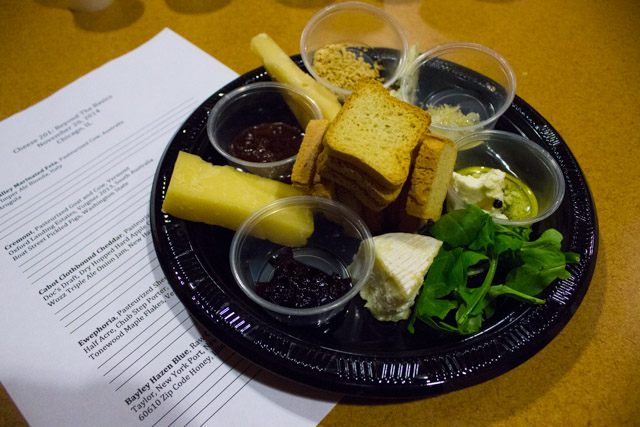5 Things We Learned At Cheese 201
By Erika Kubick in Food on Nov 21, 2014 8:00PM

The featured cheeses of the night with accoutrement.
Over the last eight years, Thomas Perry has cultivated a prime knowledge in cheese. He’s cooked at Formaggio Kitchen in Boston, made cheese at Cato Corner in Connecticut, and now curates the cheese program at Chicago’s Potash Market (875 N State St.). Last night, we attended Thomas’s Cheese 201 class to pick his cheesed out brain and learn how to pair our wedges for the holiday season.
Thomas provided his students with five cheeses, each paired with a beverage and accoutrement. Our favorite was the Cabot Clothbound Cheddar, a classic British-inspired cheese, paired with a triple ale onion jam and Doc’s Draft Dry Hopped Hard Cider. Thomas brought us through what makes a successful pairing, the truth about raw milk cheese and what makes us love cheese so much. We whittled the onslaught of information down to five facts for you.
1. How to pair your cheese. While there are no steadfast rules to pairing cheese, there are some guidelines that can help the novice create the perfect marriage of flavors. Goat’s milk cheeses are natural accompaniments for crisp white wines, robust sheep cheeses are well off with reds and cow’s milk cheeses can swing either way. In general, creamy cheeses call for something acidic to cut through the fatty texture. The accoutrements can either contrast the cheese, like honey and salty Stilton, or complement, like maple flakes and sweet gouda, and should also interact well with the beverage pairing. Everyone has a different palate, so don’t be afraid to take a risk.
2. Experience the pairing in three steps. You can pair a cheese with jams, honeys, pickled figs or anything you’d like, but it’s important to allow the cheese to speak for itself first. Explore a cheese in three steps. First, try the cheese on its own and study the aroma, flavor and texture. Next, try the cheese with a sip of your paired beverage, allowing the flavors to mingle. Finally, add the accoutrement and try all three elements. Notice how the elements interact and play off one another.
3. Of mites and men. Cheese is very much alive: bacteria, molds and even mites are part of the delicate eco-system that make our cheeses so delicious. Cheese mites are tiny spider-like bugs that love cheese just as much as we do. They sit on the outside of some cheeses and munch away, contributing to the formation of the rind and flavor of the cheese. It might seem cringe-worthy, but if you’ve ever had a crunchy, caramel-colored wedge of mimolette or a butter chunk of Comté, then you’ve eaten cheese mites. Some mites can get out of hand, which is why some cheeses are oiled or even vacuumed to prevent damage from gluttonous mites.
4. Don’t fear raw cheeses. Pasteurization is the process of heating milk to kill possible pathogens. In America, the milk is heated at 145° F for 30 minutes or 161°F for 30 seconds. The FDA requires that raw cheeses be aged for 60 days before distribution, long enough to ward off harmful listeria. Unfortunately, pasteurization can mean more harm than good in the dairy world. First of all, raw milk cheeses are often superior in flavor and texture than their pasteurized counterparts, showcasing distinct notes of the terroir and the animals diet. Furthermore, mass producers of cheese can use pasteurization as a safety net for poor practices and filthy living conditions. Raw milk producers keep facilities that are far cleaner than your apartment.
5. Cheese is sex. There’s a reason that people love cheese as much as they do. You know those tiny, crunchy crystals found in aged goudas and Parmigiano-Reggiano? Those are little amino acids called Tyrosine. Like sex and hard drugs such as cocaine, Tyrosine stimulates dopamine transmitters in your brain, causing pleasurable sensations. Whenever you’re feeling down in the dumps, know that cheese is always there to bring you back up.
Aching for more cheese knowledge? Look for Thomas’s next cheese class in 2015 or stop in to Potash Market on State Street and hit up the cheese counter. Thomas also suggested literature for cheese enthusiasts looking to delve deeper into the world of cheese:
- 1. Cheese Primer by Steven Jenkins: written in 1996, this dated but informative book will provide you with a sturdy base knowledge.
- 2. Mastering Cheese by Max McCalman: McCalman is well-respected in the cheese community. He’s written several books, but Mastering Cheese is the most approachable and educational cheese book available today.
- 3. The Cheese Room by Patricia Michelson: this book will not only teach you all you need to know about cheese, but the cooking section will inform you in the kitchen as well.
- 4. Cheese Monger by Gordon Edgar: does cheese mongering seem like the career for you? Check out Gordon Edgar’s autobiography, chronicling his “Life on the Wedge”.